Thank you to all of the writers, academics, scholars, & historians who provided us with these great works for all of us to learn and enjoy !
If you have any books to recommend that we can add to our bookstore, please let us know.
Write us at info@dragkinghistory.com
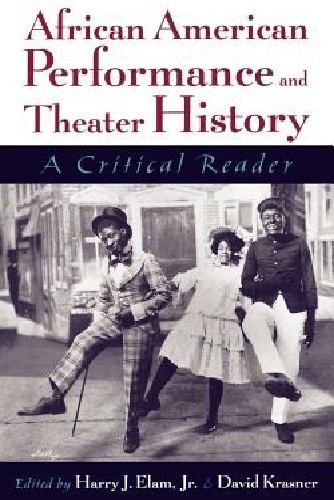
African American Performance and Theater
Edited by Harry J. Elam Jr and David Krasner
Published by Oxford University Press, 2001
African-American Performance and Theatre History is an anthology of critical writings that explores the intersections of race, theater, and performance in America. Assembled by two esteemed scholars in black theater and composed of essays from acknowledged authorities in the field, this volume is organized into four sections representative of the ways black theater, drama, and performance past and present interact and enact continuous social, cultural, and political dialogues. The premise behind the book is that analyzing African-American theater and performance traditions offers insight into how race has operated and continues to operate in American society. The only one-volume collection of its kind, this volume is likely to become the central reference for those studying black theater.

The Art of Drag
by Jake Hall, Sofie Birkin, Helen Li, Jasjyot Singh Hans
Published by Nobrow, 2020
Before RuPaul’s Drag Race propelled the cultural phenomenon into the global spotlight, drag had been around for thousands of years. Immerse yourself in the rich history of drag in this lusciously illustrated guide, brimming with dazzling colors and fabulous facts, all held together with a unique Swiss binding that lets each spread lay flat so that you can experience this book in all its trailblazing glory! The history of drag has been formed by many intersections: fashion, theatre, sexuality and politics–all coming together to create the show stopping entertainment millions witness today. In this extensive work, Jake Hall delves deep into the ancient beginnings of drag, to present day and beyond. Vibrant illustrations enhance the rich history from Kabuki theatre to Shakespearean, the revolutionary Stonewall riots to the still thriving New York ballroom scene. Nothing will go undocumented in this must-have documentation of all things drag.
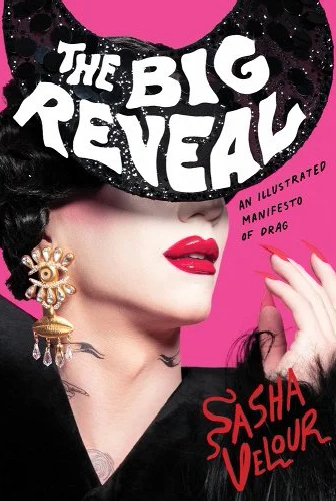
The Big Reveal: An Illustrated Manifesto of Drag
by Sasha Velour
Published by HarperCollins, April 4, 2023
“Drag embodies the queer possibility that exists within each of us—the infinite ways in which gender, good taste, and art can be lived.” –Sasha Velour
This book is a quilt, piecing together memoir, history, and theory into a living portrait of an artist and an art. Within these pages, illustrated throughout with photos and original artwork, Sasha Velour illuminates drag as a unique form of expression with a rich history and a revolutionary spirit.
Each chapter strips off a new layer, removing one tantalizing glove and then another, to reveal all the twists and turns in the life of a queen. As Sasha recalls her own journey, from the women who raised her, to learning the craft of an artist, to success, disaster, and more, she also uncovers the history of queer life around the world that made it all possible.
From shamans to “fairies balls,” empresses to RuPaul’s Drag Race (and beyond), The Big Reveal chronicles and celebrates our shared queer pasts. “If we want to be seen as legendary,” writes Sasha, “we have to weave ourselves into history.”
From an iconoclastic drag queen comes an equally singular, thought-provoking manifesto that brings necessary and sparkling substance to our understanding of drag, queerness, beauty, and liberation!
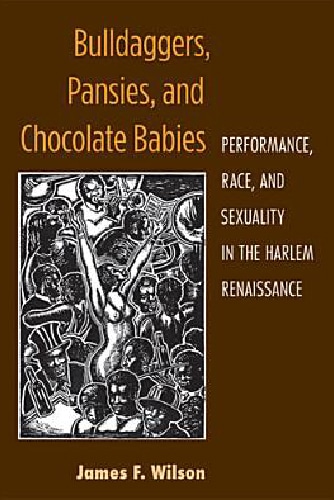
Bulldaggers, Pansies, and Chocolate Babies
by James F. Wilson
Published by University of Michigan Press, 2011
Bulldaggers, Pansies, and Chocolate Babies shines the spotlight on historically neglected plays and performances that challenged early twentieth-century notions of the stratification of race, gender, class, and sexual orientation. On Broadway stages, in Harlem nightclubs and dance halls, and within private homes sponsoring rent parties, African American performers of the 1920s and early 1930s teased the limits of white middle-class morality. Blues-singing lesbians, popularly known as “bulldaggers,” performed bawdy songs; cross-dressing men vied for the top prizes in lavish drag balls; and black and white women flaunted their sexuality in scandalous melodramas and musical revues. Race leaders, preachers, and theater critics spoke out against these performances that threatened to undermine social and political progress, but to no avail: mainstream audiences could not get enough of the riotous entertainment.
Many of the plays and performances explored here, central to the cultural debates of their time, had been previously overlooked by theater historians. Among the performances discussed are David Belasco’s controversial production of Edward Sheldon and Charles MacArthur’s Lulu Belle (1926), with its raucous, libidinous view of Harlem. The title character, as performed by a white woman in blackface, became a symbol of defiance for the gay subculture and was simultaneously held up as a symbol of supposedly immoral black women. African Americans Florence Mills and Ethel Waters, two of the most famous performers of the 1920s, countered the Lulu Belle stereotype in written statements and through parody, thereby reflecting the powerful effect this fictional character had on the popular imagination.
Bulldaggers, Pansies, and Chocolate Babies is based on historical archival research including readings of eyewitness accounts, newspaper reports, songs, and playscripts. Employing a cultural studies framework that incorporates queer and critical race theory, it argues against the widely held belief that the stereotypical forms of black, lesbian, and gay show business of the 1920s prohibited the emergence of distinctive new voices. Specialists in American studies, performance studies, African American studies, and gay and lesbian studies will find the book appealing, as will general readers interested in the vivid personalities and performances of the singers and actors introduced in the book.
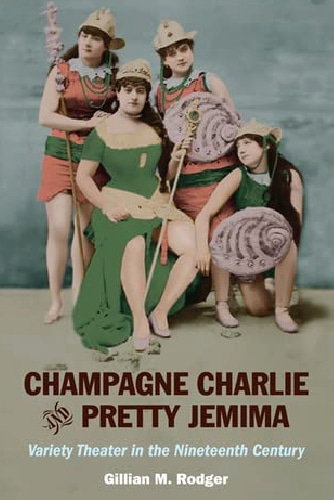
Champagne Charlie and Pretty Jemima
by Gillian M. Roger
Published by University of Illinois Press, 2010
In this rich, imaginative survey of variety musical theater, Gillian M. Rodger masterfully chronicles the social history and class dynamics of the robust, nineteenth-century American theatrical phenomenon that gave way to twentieth-century entertainment forms such as vaudeville and comedy on radio and television. Fresh, bawdy, and unabashedly aimed at the working class, variety honed in on its audience’s fascinations, emerging in the 1840s as a vehicle to accentuate class divisions and stoke curiosity about gender and sexuality. Cross-dressing acts were a regular feature of these entertainments, and Rodger profiles key male impersonators Annie Hindle and Ella Wesner while examining how both gender and sexuality gave shape to variety. By the last two decades of the nineteenth century, variety theater developed into a platform for ideas about race and whiteness.
As some in the working class moved up into the middling classes, they took their affinity for variety with them, transforming and broadening middle-class values. Champagne Charlie and Pretty Jemima place the saloon keepers, managers, male impersonators, minstrels, acrobats, singers, and dancers of the variety era within economic and social contexts by examining the business models of variety shows and their primarily white, working-class urban audiences. Rodger traces the transformation of variety from sexualized entertainment to more family-friendly fare, domestication that mirrored efforts to regulate the industry, as well as the adoption of aspects of middle-class culture and values by the shows’ performers, managers, and consumers.

The Changing Room: Sex, Drag and Theatre
by Laurence Senelick
Published by Routledge, 2000
The answers to these questions – and much, much more – are to be found in The Changing Room, which traces the origins and variations of theatrical cross-dressing through the ages and across cultures. It examines:
• tribal rituals and shamanic practices in the Balkans and Chinese-Tibet
• the gender-bending elements of Greek and early Christian religion
• the homosexual appeal of the boy actor on the traditional stage of China, Japan and England
• the origins of the dame comedian, the principal boy, the glamour drag artiste and the male impersonator
• artists such as David Bowie, Boy George, Charles Ludlam, Dame Edna Everage, Lily Savage, Candy Darling, Julian Clary and the New York Dolls.
Lavishly illustrated with unusual and rare pictures, this is the first ever cross-cultural study of theatrical transvestism. It is a must for anyone interested in cross-dressing, theatre, and gender.
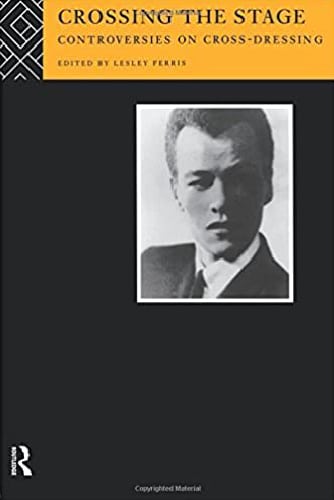
Crossing the Stage: Controversies on Cross-Dressing
Edited by Lesley Ferris
Published by Routledge, 1993
Crossing the Stage brings together for the first time essays which explore cross-dressing in theatre, cabaret, opera and dance. The volume contains seminal pieces which have become standard texts in the field, as well as new work especially commissioned from leading writers on performance.
Crossing the Stage is an indispensable sourcebook on theatrical cross-dressing. It will be essential reading for all those interested in performance and the representation of gender.
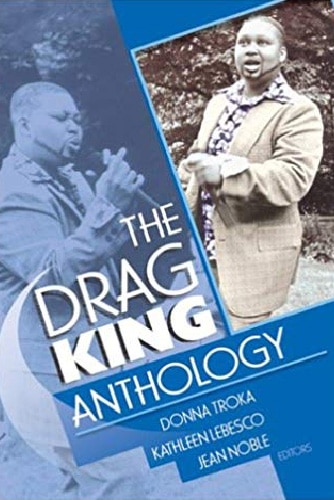
The Drag King Anthology
by Donna Troka, Kathleen Lebesco, Jean Noble
Dispelling the myth that drag kings are simply, “women doing drag”, the Drag King Anthology, presents enlightening essays that address gender, sexuality and feminism.Using prose, poetry and, photographs, an eclectic mix of scholars, performers and fans offer cultural and political, insights on the international growth and, development of drag king troupes and communities.
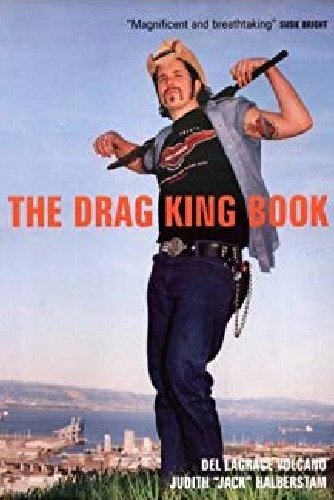
The Drag King Book
by Judith “Jack” Halberstam & Del LaGrace Volcano
This book, the first to chart the explosive rise of drag kings, combines the photographs of (100 of drag kings from London, New York, and San Francisco) Del LaGrace Volcano with the text of Judith Halberstam.

Drag: The Complete Story
by Simon Doonan
Drag is transformation, communication, and, above all, exaggeration, where gender non-conformity is the plat du jour. This fearless book observes this increasingly complex world by exploring drag’s journey – from the surprising, to the sophisticated, to the utterly bizarre – through the twentieth century and up to the present day.
With witty text, dazzling photography, and corralled into thematic chapters, this is the first flamboyant and poignant survey of drag culture. Drag is not just for fabulous queens and drag enthusiasts, but for anyone interested in gender fluidity and the culture surrounding it.
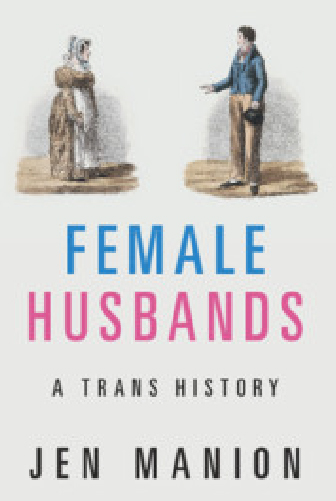
Female Husbands: A Trans History
by Jen Manion
Published by Cambridge University Press, March 2020
Long before people identified as transgender or lesbian, there were female husbands and the women who loved them. Female husbands – people assigned female who transed gender, lived as men, and married women – were true queer pioneers. Moving deftly from the colonial era to just before the First World War, Jen Manion uncovers the riveting and very personal stories of ordinary people who lived as men despite tremendous risk, danger, violence, and threat of punishment. Female Husbands weaves the story of their lives in relation to broader social, economic, and political developments in the United States and the United Kingdom while also exploring how attitudes towards female husbands shifted in relation to transformations in gender politics and women’s rights, ultimately leading to the demise of the category of ‘female husband’ in the early twentieth century. Groundbreaking and influential, Female Husbands offers a dynamic, varied, and complex history of the LGBTQ past.

Female Masculinity
by Jack Halberstam
Published by Duke University Press, 1998
In this quintessential work of queer theory, Jack Halberstam takes aim at the protected status of male masculinity and shows that female masculinity has offered a distinct alternative to it for well over two centuries. Demonstrating how female masculinity is not some bad imitation of virility, but a lively and dramatic staging of hybrid and minority genders, Halberstam catalogs the diversity of gender expressions among masculine women from nineteenth-century pre-lesbian practices to contemporary drag king performances. Through detailed textual readings as well as empirical research, Halberstam uncovers a hidden history of female masculinities while arguing for a more nuanced understanding of gender categories that would incorporate rather than pathologize them. He rereads Anne Lister’s diaries and Radclyffe Hall’s The Well of Loneliness as foundational assertions of female masculine identity; considers the enigma of the stone butch and the politics surrounding butch/femme roles within lesbian communities; and explores issues of transsexuality among “transgender dykes”-lesbians who pass as men-and female-to-male transsexuals who may find the label of “lesbian” a temporary refuge. Halberstam also tackles such topics as women and boxing, butches in Hollywood and independent cinema, and the phenomenon of male impersonators. Featuring a new preface by the author, this twentieth anniversary edition of Female Masculinity remains as insightful, timely, and necessary as ever.
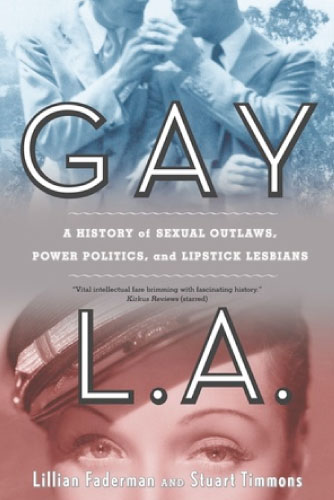
Gay L. A.: A History of Sexual Outlaws, Power Politics, and Lipstick Lesbians
by Lillian Faderman and Stuart Timmons
Award-winning historian Lillian Faderman teams with journalist Stuart Timmons to write the first history of gay life in America’s ultimate frontier town: Los Angeles
The exhortation to “Go West!” has always had a strong hold on the American imagination. But for the gays, lesbians, and transgendered people who have moved to L.A. over the past two centuries, the City of Angels has offered a special home–which, in turn, gave rise to one of the most influential gay cultures in the world.
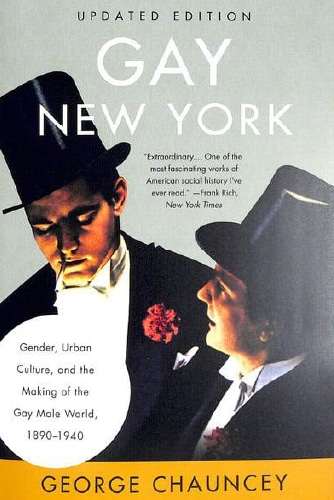
Gay New York: Gender, Urban Culture, and the Making of the Gay Male World, 1890-1940
by George Chauncey
The award-winning, field-defining history of gay life in New York City in the early to mid-20th century. Gay New York brilliantly shatters the myth that before the 1960s gay life existed only in the closet, where gay men were isolated, invisible, and self-hating. Drawing on a rich trove of diaries, legal records, and other unpublished documents, George Chauncey constructs a fascinating portrait of a vibrant, cohesive gay world that is not supposed to have existed. Called “monumental” (Washington Post), “unassailable” (Boston Globe), “brilliant” (Nation), and “a first-rate book of history” (New York Times), Gay New York forever changed how we think about the history of gay life in New York City, and beyond.

Gender Gymnastics: Performing and Consuming Japan’s Takarazuka Revue
by Leonie R. Stickland
Published by Trans Pacific Press, 2008
The artifice of gender performance, sometimes playful, mostly conscientious, has enthralled and entertained audiences of Japan’s all-female Takarazuka Revue for more than 90 years. The dashing male-role players in its musical theatre productions enjoy the adulation of a predominantly female audience for whom these handsome idols represent ideal masculinity, while, at the same time, these ‘men’ in turn are reflected and magnified by the overwrought femininity of their female-role counterparts. This volume resounds with the voices of those closest to Takarazuka, the girls and women who have danced, sung, and acted in its limelight. Using exclusive interviews, historical records, autobiographies, and years of close-hand observations, former Revue translator and voice actor Leonie Stickland extensively explores the aspirations, endeavors, and experiences of Takarazuka’s creators, performers, and adoring fans. Stickland’s book simultaneously elucidates gender issues which have impacted upon the life-stages of women in Japan throughout the past century.
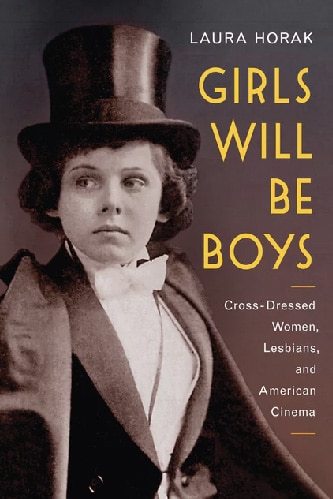
Girls Will Be Boys
by Laura Horak
Marlene Dietrich, Greta Garbo, and Katharine Hepburn all made lasting impressions with the cinematic cross-dressing they performed onscreen. What few modern viewers realize, however, is that these seemingly daring performances of the 1930s actually came at the tail end of a long wave of gender-bending films that included more than 400 movies featuring women dressed as men.
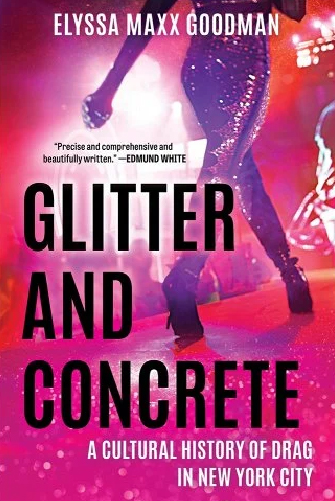
Glitter and Concrete: A Cultural History of Drag in New York City
by Elyssa Maxx Goodman
Published by Hanover Square Press, 2023
An intimate, evocative history of drag in New York City exploring its dynamic role, from the Jazz Age to Drag Race,in queer liberation and urban life
From the lush feather boas that adorned early female impersonators to the sequined lip syncs of barroom queens to the drag kings that have us laughing in stitches, drag has played a vital role in the creative life of New York City. But the evolution of drag in the city—as an art form, a community and a mode of liberation—has never before been fully chronicled.
Now, for the first time, journalist and drag historian Elyssa Maxx Goodman unearths the dramatic, provocative untold story of drag in New York City in all its glistening glory. Goodman ducks beneath the velvet ropes of Harlem Renaissance balls, examines drag’s crucial role in the Stonewall Uprising, traces drag’s influence on disco and punk rock as well as its unifying power during the AIDS crisis and 9/11, and culminates in the era of RuPaul’s Drag Race.
Informed by meticulous research and archival work, as well as original interviews with high-profile performers, Glitter and Concrete is a significant contribution to queer history and an essential read for anyone curious about the story that echoes beneath the heels.

A History of the Takarazuka Revue Since 1914: Modernity, Girls’ Culture, Japan Pop
By Makiko Yamanashi
Published by Brill, 2012
Founded in the hot-spring resort town of the same name in 1914, Takarazuka is a kaleidoscopic medium, both in terms of its theatricality and visual characteristics. Yet, despite its prominence and popularity, it has not received the academic attention it deserves, especially in the context of theatre studies. This book, therefore, by taking an interdisciplinary approach, endeavours to fill this gap through a detailed analysis of the Takarazuka Revue Company’s history, educational traditions and theatrical ethos viewed from the prism of Japan’s modernization and globalization in the twentieth century. Its important relationship to Japanese popular culture, especially in the fields of manga and fashion are also given due consideration. Furthermore, because of its unique features as an all-female performance art appealing mostly to female Japanese audiences, the study also includes an in-depth consideration of its continuing success, way of life and wider social impact from both cultural and social perspectives. With Takarazuka’s centenary fast approaching, A History of the Takarazuka Revue Since 1914 will have wide interdisciplinary appeal, as well as in the particular context of Japanese Studies. Illustrated throughout, supported by an extensive bibliography, it is divided into five chapters: leaves The Formative Years of Takarazuka; 2. The Mechanisms of Takarazuka; 3. The Stage Art of Takarazuka ‘Fantasy Adventure’; 4. The Taishō ‘Modern’; in the Female Domain of Shōjo Bunka; 5. Takarazuka in the Modern Heritage of Girls’ Culture and Beyond.
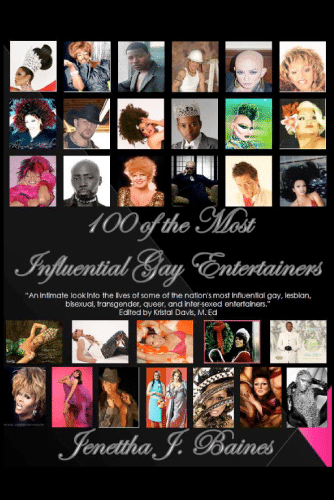
100 of the Most Influential Gay Entertainers
by Jenettha J. Baines
Original couture fashion design. Flawless makeup. Perfectly executed performances. Attention-commanding stage presence. This is only the beginning of what makes an entertainer engaging and truly memorable. Welcome to a backstage pass into the intimate details of the lives of some of the world’s most influential gay, lesbian, bisexual, transgender, queer, and inter-sexed entertainers. These are their stories. Discover their fears and motivations. Experience the joy, excitement and fascination of working in the entertainment business.
These entertainers are locally appreciated, nationally known, and world traveled. They have performed everywhere from small smoke-filled clubs to Las Vegas stages. Their impact on the GLBTQI (gay, lesbian, bisexual, transgender, queer, inter-sexed) communities in the United States and around the world is immeasurable. Entertainers such as RuPaul’s Drag Race contestants Nina Flowers, Ongina, and Rebecca Glasscock; legendary performers Mr. Charlie Brown from the infamous Backstreets of Atlanta; Tommie Ross and Hawaiian Goddess Dina Jacobs; celebrity impersonators Hot Chocklate as Tina Turner, Coti Collins as Reba McIntyre, Leigh Shannon as Bette Miller, and Andy “6-Pak” Citino as Kid Rock; Queen of Hawaii Tiana Anderson, Queen of Bermuda Sybil Barrington; the many faces of Tasha Long; the mother of Atlanta Niesha Dupree; female-to-male illusionists Romance St. James and Gage Gatlyn; the multi-talented actress and star of “The Dred Love Experience”, MilDred “DRED” Gerestant; the beautiful and talented Raquell Lord, Erica Andrews and Stasha Sanchez; “at large” Kelexis Davenport, Chelsea Pearl and former Alvin Ally student and house music diva Ebonee Excell; New York actress and comedian Harmonica Sunbeam and her sidekick Sugga Pie Koko, and the greatest femme and stud promoters of all time, Miss Theresa from New Jersey, Regina Franklin from Atlanta, Madison from New York, and many, many more entertainers across the United States and beyond!
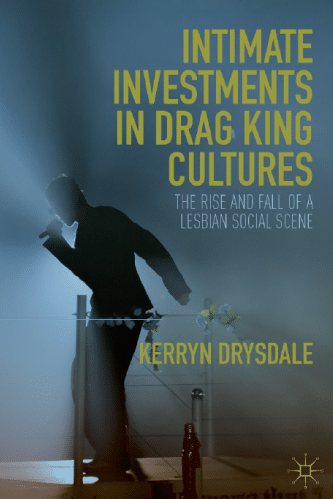
Intimate Investments in Drag King Cultures
The Rise and Fall of a Lesbian Social Scene
by Kerryn Drysdale
This book takes the globally recognised phenomenon of drag king performances as an opportunity for critical inquiry into the rise and fall of an urban scene for lesbian and queer women in Sydney, Australia (circa 1999-2012). But what happens when scenes fade, as they invariably do? Intimate Investments in Drag King Cultures is unique in capturing the perspective of a scene at the moment of its decline, revealing the process by which the contemporary drag king movement becomes layered with historical significance.
For a FREE PDF Download of this book, please contact the author Kerryn Drysdale. She will happily send you a copy.

Just One of the Boys
by Gillian M. Rodger
Female-to-male crossdressing became all the rage in the variety shows of nineteenth-century America and began as the domain of mature actresses who desired to extend their careers. These women engaged in the kinds of raucous comedy acts usually reserved for men. Over time, as younger women entered the specialty, the comedy became less pointed and more centered on the celebration of male leisure and fashion
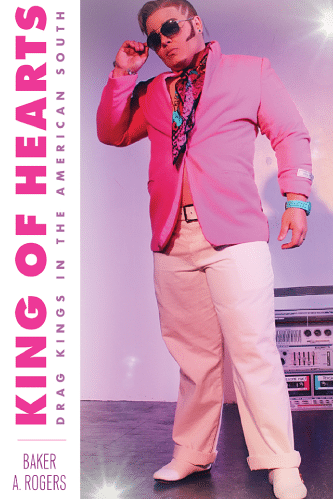
King of Hearts: Drag Kings in the American South
by Baker A. Rogers
Published by Rutgers University Press, 2021
While drag subcultures have gained mainstream media attention in recent years, the main focus has been on female impersonators. Equally lively, however, is the community of drag kings: cis women, trans men, and non-binary people who perform exaggerated masculine personas onstage under such names as Adonis Black, Papi Chulo, and Oliver Clothesoff.
King of Hearts shows how drag king performers are thriving in an unlikely location: Southern Bible Belt states like Tennessee, Georgia, and South Carolina. Based on observations and interviews with sixty Southern drag kings, this study reveals how they are challenging the region’s gender norms while creating a unique community with its own distinctive Southern flair. Reflecting the region’s racial diversity, it profiles not only white drag kings, but also those who are African American, multiracial, and Hispanic.
Queer scholar Baker A. Rogers—who has also performed as drag king Macon Love—takes you on an insider’s tour of Southern drag king culture, exploring its history, the communal bonds that unite it, and the controversies that have divided it. King of Hearts offers a groundbreaking look at a subculture that presents a subversion of gender norms while also providing a vital lifeline for non-gender-conforming Southerners.

Drag Kings: Mit Bartkleber gegen das Patriarchat
(Drag Kings: With Beard Glue Against Patriarchy)
by Pia Thilman, Tania Witte & Ben Rewald
Published by Querverlag GmbH, Berlin 2007
Dieser farbenfrohe Band zeigt locker und unverkrampft, tiefgründig und verführerisch, was Menschen dazu bringt, den langen ausschließlich von Queens bevölkerten Drag-Sektor zu erweitern.
Prosa und Interviews werden illustriert von Comics und Fotos. Die Erotik der Drag Kings ist dabei genauso Thema wie Forschungen aus den Genderstudies zu dieser noch jungen Kunstform; Geschlechtergrenzen werden als bloße Konstruktionen auseinander genommen und VertreterInnen feministischer Kritik schütten eine gehörige Portion Ironie über den Machos und Gentlemen aus, die zwischen den Geschlechterrollen tänzelnd zu Sexsymbolen avancieren.
Loose and uninhibited, deep and seductive, this colorful volume showcases what drives people to expand the long queen-only drag sector.
Prose and interviews are illustrated with comics and photos. The eroticism of the drag kings is just as much a topic as research from gender studies on this still young art form; Gender boundaries are taken apart as mere constructions and representatives of feminist criticism pour out a good dose of irony about the machos and gentlemen who dance between gender roles and become sex symbols.
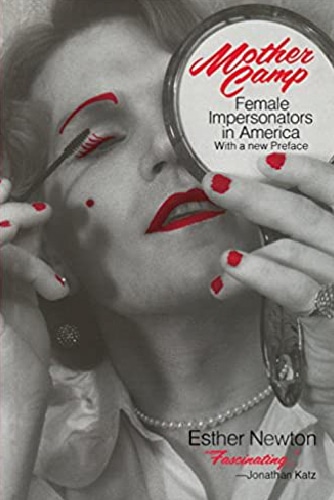
Mother Camp
by Esther Newton
For two years Esther Newton did field research in the world of drag queens—homosexual men who make a living impersonating women. Newton spent time in the noisy bars, the chaotic dressing rooms, and the cheap apartments and hotels that make up the lives of drag queens, interviewing informants whose trust she had earned and compiling a lively, first-hand ethnographic account of the culture of female impersonators. Mother Camp explores the distinctions that drag queens make among themselves as performers, the various kinds of nightclubs and acts they depend on for a living, and the social organization of their work. A major part of the book deals with the symbolic geography of male and female styles, as enacted in the homosexual concept of “drag” (sex role transformation) and “camp,” an important humor system cultivated by the drag queens themselves.
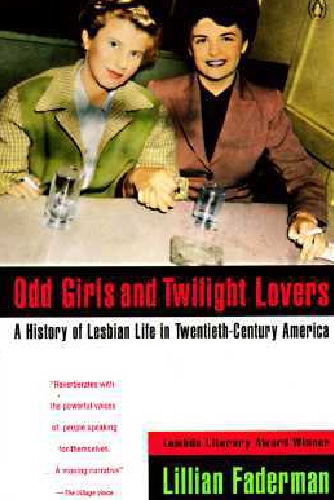
Odd Girls and Twilight Lovers: A History of Lesbian Life in Twentieth-Century America
by Lillian Faderman
Lillian Faderman tells the compelling story of lesbian life in the 20th century, from the early 1900s to today’s diverse lifestyles. Using journals, unpublished manuscripts, songs, news accounts, novels, medical literature, and numerous interviews, she relates an often surprising narrative of lesbian life. “A key work…the point of reference from which all subsequent studies of 20th-century lesbian life in the United States will begin.”—San Francisco Examiner.
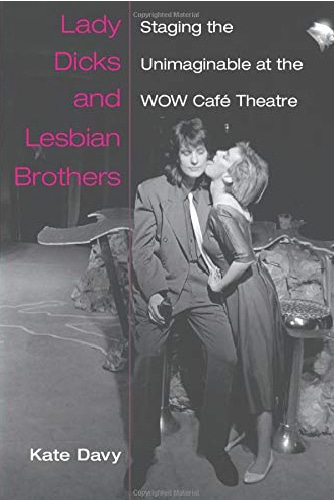
Lady Dicks and Lesbian Brothers – Staging the Unimaginable at the WOW Café Theatre
by Katy Davy
Published by The University of Michigan Press, 2011
Out of a small, hand-to-mouth women’s theater collective called the WOW Café located on the lower east side of Manhattan there emerged some of the most important theater troupes and performance artists of the 1980s and 1990s. Appearing on the cultural scene at a critical turning point in both the women’s movement and feminist theory, WOW put a witty, hilarious, gender-bending, and erotically charged aesthetic on stage for women in general and lesbians in particular. Featured performers included the Split Britches Company, the Five Lesbian Brothers, Carmelita Tropicana, Holly Hughes, Lisa Kron, Deb Margolin, Reno, Peggy Shaw, and Lois Weaver. For three decades the WOW Café Theatre has nurtured fledgling women writers, designers, and performers who continue to create important performance work. Lady Dicks and Lesbian Brothers offers the first critical history of the WOW Café, based on dozens of interviews with WOW performers and other participants, newspaper reviews of the earliest productions, and unpublished photographs, and suggests why the collective has had such amazing longevity and an enduring legacy.

Memories of the Revolution: The First Ten Years of the WOW Café Theater
Edited by: Holly Hughes, Carmelita Tropicana, and Jill Dolan
Published by The University of Michigan Press, 2015
The women’s experimental theater space called the WOW Café (Women’s One World) has been a vital part of New York’s downtown theater scene since 1980. Since that time, WOW has provided a place for feminist and particularly lesbian theater artists to create, perform, and witness a cultural revolution. Its renowned alumnae include playwright and actor Lisa Kron, performance artists Holly Hughes and Carmelita Tropicana, the theater troupe the Five Lesbian Brothers, and actors/playwrights Peggy Shaw, Lois Weaver, and Deb Margolin, among others.
Memories of the Revolution collects scripts, interviews, and commentary to trace the riotous first decade of WOW. While the histories of other experimental theater collectives have been well documented, WOW’s history has only begun to be told. The anthology also includes photographs of and reminiscences by Café veterans, capturing the history and artistic flowering of the first ten years of this countercultural haven.
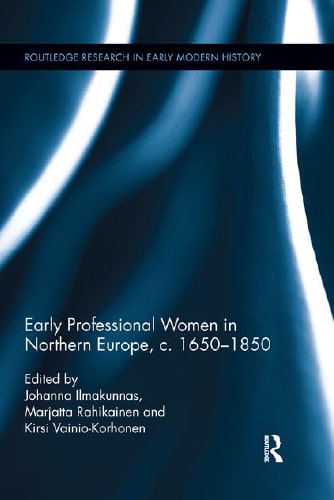
Early Professional Women in Northern Europe, c. 1650-1850
Edited by Johanna Ilmakunnas, Marjatta Rahikainen and Kirsi Vainio-Korhonen
This book focuses on early examples of women who may be said to have anticipated, in one way or another, modern professional and/or career-oriented women. The contributors to the book discuss women who may at least in some respect be seen as professionally ambitious, unlike the great majority of working women in the past. In order to improve their positions or to find better business opportunities, the women discussed in this book invested in developing their qualifications and professional skills, took economic or other kinds of risks, or moved to other countries. Socially, they range from elite women to women of middle-class and lower middle-class origin.
In terms of theory, the book brings fresh insights into issues that have been long discussed in the field of women’s history and are also debated today. However, despite its focus on women, the book is conceptually not so much focused on gender as it is on profession, business, career, qualifications, skills, and work. By applying such concepts to analyzing women’s endeavours, the book aims at challenging the conventional ideas about them.

Queering Drag: Redefining the Discourse of Gender-Bending
by Meredith Heller
Published by Indiana University Press, 2020
Theatrical gender-bending, also called drag, is a popular form of entertainment and a subject of scholarly study. However, most drag studies do not question the standard words and ideas used to convey this performance genre. Drawing on a rich body of archival and ethnographic research, Meredith Heller illuminates diverse examples of theatrical gender-bending: male impersonation in variety and vaudeville (1860-1920); the “sexless” gender-bending of El Teatro Campesino (1960-1980); queer butch acts performed by black nightclub singers,; and the range of acts that compose contemporary drag king shows. Heller highlights how, in each case, standard drag discourses do not sufficiently capture the complexity of performers’ intents and methods, nor do they provide a strong enough foundation for holistically evaluating the impact of this work. Queering Drag offers redefinition of the genre centralized in the performer’s construction and presentation of a “queer” version of hegemonic identity, and it models a new set of tools for analyzing drag as a process of intents and methods enacted to effect specific goals. This new drag discourse not only allows for more complete and accurate descriptions of drag acts, but it also facilitates more ethical discussions about the bodies, identities, and products of drag performers.

Sex, Drag, and Male Roles
by Diane Torr & Stephen Bottoms
This book documents the evolution of Torr’s work by blending first-person memoir and commentary from Torr with critical reflections and contextualization from leading performance critic Stephen J. Bottoms. The book includes a consideration of the long cultural history of female-to-male cross-dressing and concludes with Torr’s “Do-It-Yourself” guide to becoming a “Man for a Day.”
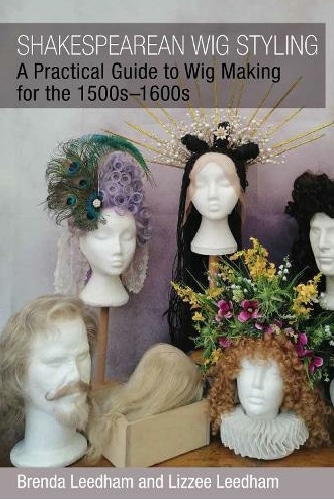
Shakespearean Wig Styling
By Brenda Leedham and Lizzee Leedham
Published by The Crowood Press Ltd, 2020
The poetry and plays of William Shakespeare continue to provide inspiration for designers in all aspects of media. Shakespearean Wig Styling offers detailed historical guidance on the styles and fashions of the day, and guides you through twelve different wig designs covering a wide range of archetypal Shakespearian characters. Each example offers different techniques to meet the needs of the design, from material, knotting and curling to the final styling choices. Covering both the Tudor and Stuart periods, there are clear instructions within each example for making wigs from start to finish and adapting from the universal full-lace foundation to create alternative foundations, including added support for complicated styles such as the fontange. In addition, the book covers what to expect when working in the theatre or as a freelance wig-maker; fitting your client, measuring and taking a shell; methods for preparing the hair under a wig; knotting facial hair, hairpieces, hairlines, napes and partings; methods for breaking or dirtying down and finally, creating bald caps and receding hairline effects. This comprehensive book is an ideal companion for the newly qualified wig-maker and all professionals looking for a detailed reference guide to hairstyles from the Shakespearean era. 339 colour photos and 6 black & white photos.
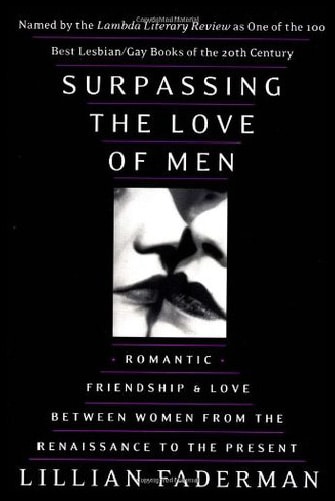
Surpassing the Love of Men: Romantic Friendship and Love Between Women from the Renaissance to the Present
by Lillian Faderman
A classic of its kind, this fascinating cultural history draws on everything from private correspondence to pornography to explore five hundred years of friendship and love between women. Surpassing the Love of Men throws a new light on shifting theories of female sexuality and the changing status of women over the centuries.
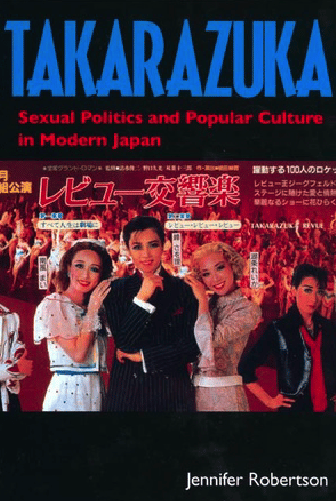
Takarazuka: Sexual Politics and Popular Culture in Modern Japan
by Jennifer Robertson
Published by University of California Press, 1998
The all-female Takarazuka Revue is world-famous today for its rococo musical productions, including gender-bending love stories, torridly romantic liaisons in foreign settings, and fanatically devoted fans. But that is only a small part of its complicated and complicit performance history. In this sophisticated and historically grounded analysis, anthropologist Jennifer Robertson draws from over a decade of fieldwork and archival research to explore how the Revue illuminates discourses of sexual politics, nationalism, imperialism, and popular culture in twentieth-century Japan.
The Revue was founded in 1913 as a novel counterpart to the all-male Kabuki theater. Tracing the contradictory meanings of Takarazuka productions over time, with special attention to the World War II period, Robertson illuminates the intricate web of relationships among managers, directors, actors, fans, and social critics, whose clashes and compromises textured the theater and the wider society in colorful and complex ways.
Using Takarazuka as a key to understanding the “logic” of everyday life in Japan and placing the Revue squarely in its own social, historical, and cultural context, she challenges both the stereotypes of “the Japanese” and the Eurocentric notions of gender performance and sexuality.
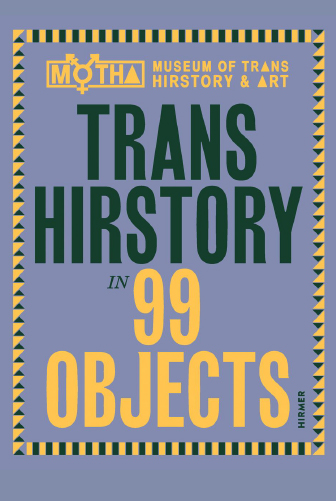
Trans Hirstory in 99 Objects
by David Evans Frantz, Christina Linden, Chris E. Vargas
A compelling exploration of trans art, activism, and resistance.
Spanning over four centuries, this volume brings together a wide-ranging selection of artworks and artifacts that highlight the under-recognized histories of trans and gender-nonconforming communities. Through the contributions of artists, writers, poets, activists, and scholars, this title reflects on historical erasure and imagines trans futures.
An expansive array of objects chart not a patriarchal history but a gender-neutral, trans-centric hirstory. The first publication of its kind, this survey celebrates trans forebearers, highlights struggles and triumphs, and reflects on the legacies of trans creative expression. Contributions by Kate Bornstein, Ria Brodell, Vaginal Davis, Leah DeVun, Mo B. Dick, Zackary Drucker, David Getsy, Martine Gutierrez, Andrea Jenkins, Jade Guarano Kuriki-Olivo (Puppies Puppies), Thomas (T.) Jean Lax, Abram J. Lewis, Miguel A. López, Amos Mac, Cyle Metzger, Deborah A. Miranda, Morgan M Page, SA Smythe, C. Riley Snorton, Dean Spade, Sandy Stone, Jeannine Tang, Michelle Tea, McKenzie Wark, and many others probe new horizons where institutional critique and trans culture meet. This book is copublished by the Museum of Trans Hirstory & Art (MOTHA), a conceptual art project of artist Chris E. Vargas that is forever “under construction” by design to allow continual transformation.
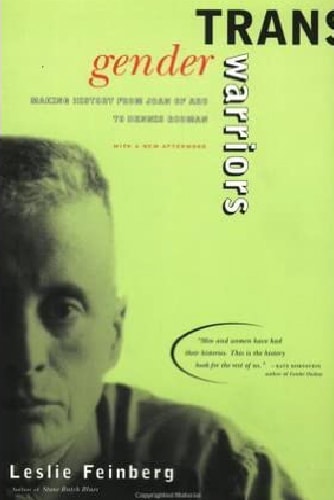
Transgender Warriors: Making History from Joan of Arc to RuPaul
by Leslie Feinberg
Published by Beacon Press, 1996
In this fascinating personal journey through history, Leslie Feinberg – one of the most prominent transgender rights activists today – unearths a vast body of evidence that throughout history there have always been people who defy cultural boundaries of sex and gender. During an embattled childhood and teenage years as a gender outlaw, Feinberg began a search for others struggling to assert an identity. What s/he found was a long tradition of individuals fighting back against injustice – from Joan of Arc to the Welsh peasants who cross-dressed to protest taxes, from the Black and Latina drag queens who led the Stonewall rebellion to transsexual parents fighting for custody today. Traditional society often exacted a terrible price from these transgender warriors, and Feinberg urges us now to receive them as hero/ines and visionaries. Illustrated with many previously unpublished historical images and contemporary photographs, Transgender Warriors is an eye-opening excursion through the history of sex and gender expression and a powerful testament to the resilient and rebellious spirit.

Vampires And Violets
by Andrea Weiss
Published by Penguin Books, 1992
A revelatory survey of lesbian identity in film–from the crossdressing stars like Garbo, Dietrich, and Hepburn to the vampire movies of the late ’60s, Silkwood and The Color Purple. With wit and political acumen, Weiss reveals the concealed world of a host of movies both popular and forgotten.
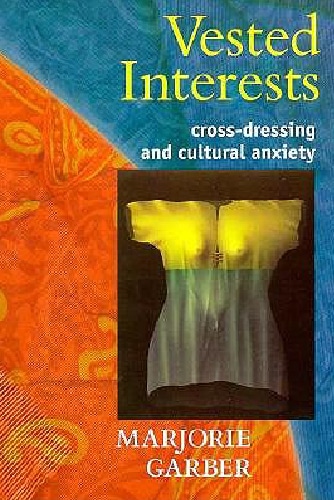
Vested Interests
by Marjorie Garber
Published by Routledge, 1997
Beginning with the bold claim, “There can be no culture without the transvestite,” Marjorie Garber explores the nature and significance of cross-dressing and of the West’s recurring fascination with it. Rich in anecdote and insight, Vested Interests offers a provocative and entertaining view of our ongoing obsession with dressing up–and with the power of clothes.

The Gay Revolution: The Story of the Struggle
by Lillian Faderman
The sweeping story of the modern struggle for gay, lesbian, and trans rights from the 1950s to the present—based on amazing interviews with politicians, military figures, legal activists, and members of the entire LGBT community who face these challenges every day.
In the words of the eyewitnesses who were there through the most critical events, The Gay Revolution paints a nuanced portrait of the LGBT civil rights movement. A defining account, this is the most complete and authoritative book of its kind.
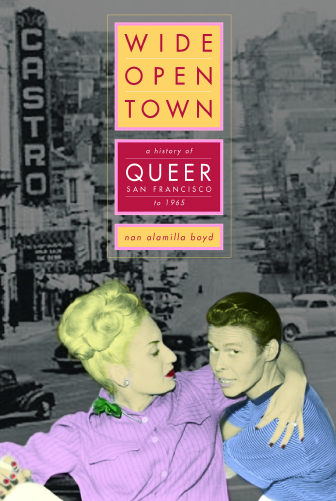
Wide Open Town
by Nan Alamilla Boyd
Published by University of California Press, 2003
Wide-Open Town traces the history of gay men and lesbians in San Francisco from the turn of the century, when queer bars emerged in San Francisco’s tourist districts, to 1965, when a raid on a drag ball changed the course of queer history. Bringing to life the striking personalities and vibrant milieu that fueled this era, Nan Alamilla Boyd examines the culture that developed around the bar scene and homophile activism. She argues that the communities forged inside bars and taverns functioned politically and, ultimately, offered practical and ideological responses to the policing of San Francisco’s queer and transgender communities. Using police and court records, oral histories, tourist literature, and manuscript collections from local and state archives, Nan Alamilla Boyd explains the phenomenal growth of San Francisco as a “wide-open town”—a town where anything goes. She also relates the early history of the gay and lesbian civil rights movement that took place in San Francisco prior to 1965.
Wide-Open Town argues that police persecution forged debates about rights and justice that transformed San Francisco’s queer communities into the identity-based groups we see today. In its vivid re-creation of bar and drag life, its absorbing portrait of central figures in the communities, and its provocative chronicling of this period in the country’s most transgressive city, Wide-Open Town offers a fascinating and lively new chapter of American queer history.
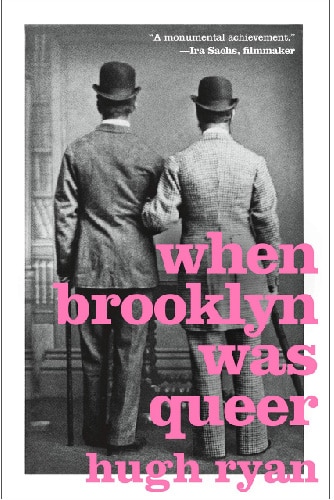
When Brooklyn Was Queer
by Hugh Ryan
Hugh Ryan’s When Brooklyn Was Queer is a groundbreaking exploration of the LGBT history of Brooklyn, from the early days of Walt Whitman in the 1850s up through the queer women who worked at the Brooklyn Navy Yard during World War II, and beyond. No other book, movie, or exhibition has ever told this sweeping story. Not only has Brooklyn always lived in the shadow of queer Manhattan neighborhoods like Greenwich Village and Harlem, but there has also been a systematic erasure of its queer history—a great forgetting.

Women Playing Men
by Jin Jiang
Published by University of Washington Press, 2009
This ground-breaking volume documents women’s influence on popular culture in twentieth-century China by examining Yue opera. A subgenre of Chinese opera, it migrated from the countryside to urban Shanghai and morphed from its traditional all-male form into an all-female one, with women cross-dressing as male characters for a largely female audience.
Yue opera originated in the Zhejiang countryside as a form of story-singing, which rural immigrants brought with them to the metropolis of Shanghai. There, in the 1930s, its content and style transformed from rural to urban, and its cast changed gender. By evolving in response to sociopolitical and commercial conditions and actress-initiated reforms, Yue opera emerged as Shanghai’s most popular opera from the 1930s through the 1980s and illustrates the historical rise of women in Chinese public culture.
Jiang examines the origins of the genre in the context of the local operas that preceded it and situates its development amid the political, cultural, and social movements that swept both Shanghai and China in the twentieth century. She details the contributions of opera stars and related professionals and examines the relationships among actresses, patrons, and fans. As Yue opera actresses initiated reforms to purge their theater of bawdy eroticism in favor of the modern love drama, they elevated their social image, captured the public imagination, and sought independence from the patriarchal opera system by establishing their own companies. Throughout the story of Yue opera, Jiang looks at Chinese women’s struggle to control their lives, careers, and public images and to claim ownership of their history and artistic representations.
